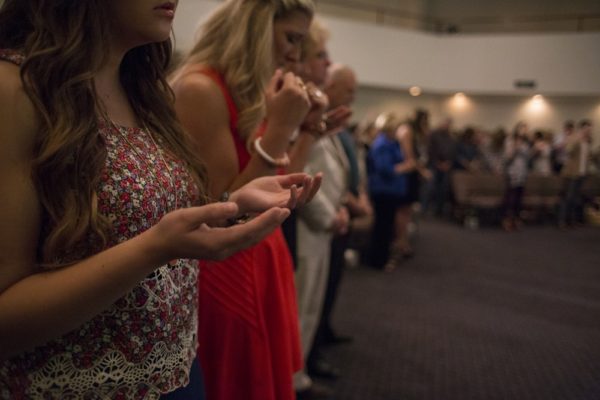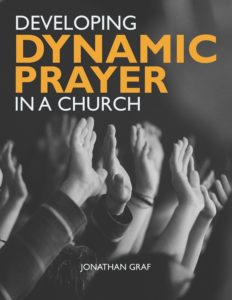By Jonathan Graf
 A number of years ago, I was preparing to go to California to facilitate a prayer weekend in a Presbyterian church there. I had been planning the event with their prayer leader and his committee. As we planned, the committee felt that it would be great to have me lead a prayer time in the two morning worship services. They had never really experienced a time where anyone other than a person from the platform would pray in the service.
A number of years ago, I was preparing to go to California to facilitate a prayer weekend in a Presbyterian church there. I had been planning the event with their prayer leader and his committee. As we planned, the committee felt that it would be great to have me lead a prayer time in the two morning worship services. They had never really experienced a time where anyone other than a person from the platform would pray in the service.
This would be an event where I would guide people to pray on a theme in groups. It would be a stretch for their staid people. They presented the idea to their pastor. He balked. We can’t make people feel uncomfortable like that, he surmised. He and I talked through what I would do. No one would be forced to pray; I would put some prayer points and a sample prayer on a power point screen; it would only go 3-4 minutes. He finally allowed it.
Even though we were nervous as to how people would respond. It went off fabulously well. People prayed. I remember standing on the platform in each service (with about 400 people or so in each) and listening to a glorious din of voices rising out of that beautiful sanctuary. During the second service I even had a vision while they were praying (something that had only happened to me once prior in my life). I told the congregation later that I saw their new multi-purpose building filled with people and many people responding to the gospel in there. I said I don’t know what that means, but watch.
The pastor got nothing but positive comments afterward, comments like, “that was so dynamic,” “I have never prayed in public before,” and “we have to do that again.” They started regularly doing prayer times like that in their services in the future. And the vision? The prayer leader emailed me about 9 months later. They had planned to do an outreach event with a Christian magician in their multi-purpose building. So many people bought tickets that they had to schedule a second “show.” Dozens responded to the gospel that weekend through the events.
Why was the response so significant? Because the prayer time was not the typical prayer most of us are used to—focused on fix-it needs that have little relation to God’s kingdom purposes. If you develop prayer that focuses outward, and that utilizes scriptural principles of corporate prayer, you will see you people get on board.
Biblical Principles of Corporate Prayer
There are five biblical principles of powerful corporate prayer. The more these elements are present in our prayer times (during worship or other times), the more powerful the prayer.
Desperation
Ezra records a time of corporate prayer surrounding a three-day fast. The priest Ezra was taking a group of Jews back to repopulate Israel. They were going to cross dangerous terrain and needed protection.
There, by the Ahava Canal, I proclaimed a fast, so that we might humble ourselves before our God and ask him for a safe journey for us and our children, with all our possessions. I was ashamed to ask the king for soldiers and horsemen to protect us from enemies on the road, because we had told the king, “The gracious hand of our God is on everyone who looks to him, but his great anger is against all who forsake him.” So we fasted and petitioned our God about this, and he answered our prayer. (Ezra 8:21-23)
They prayed out of desperation. They were in trouble if God did not come through. The interesting thing here, however, is that Ezra had a solution. Ask the King for soldiers to go along. From the pages of Ezra we see he had a good relationship with the King. The king had given them permission to go. But Ezra refused to take that option. He refused to do the obvious thing in favor of relying on God.
We need to learn from that. The more desperate we are about something, the more vibrant our prayers. When going to prayer corporately, look for ways to impress a sense of desperation in your people. Remember what happened in churches following 9/11? Prayer meetings were full for several weeks. Why?
We will see corporate prayer become more dynamic –and have greater participation—is our focus is about something with a measure of desperation in it. When you plan the focus about which to pray, figure out a way to build in desperation. Is there something happening on the world front or in your city that has people’s attention? Pray about that. When you can pray in a sense, “we can’t solve this, God; we need You,” you will see more people participate and their prayers will be filled with greater passion.
One Focus
Powerful prayer is focused prayer. It is not a shotgun approach–giving prayer requests and praying for ten different things. Effective corporate prayer is topical. The leader explains, “now we are going to pray for . . .” We see this played out in the story of Peter’s imprisonment (Acts 12). Verse 5 tells us “so Peter was kept in prison, but the church was earnestly praying to God for him.” This obviously was a very focused prayer meeting! They did not take requests and pray for everything under the sun. No, “Martha, how is that back of yours? How can we pray?” and then “Oh yeah, don’t forget Peter. Who’s got an update on Peter? He’s still in prison isn’t he. Let’s remember Peter.”
One of the ways over the years that the church has severely weakened corporate prayer is that we let prayer be about the people there, rather than about God. We allowed prayer to focus on every little fix-it need of those in attendance, and ignored the kingdom advance of God. As Daniel Henderson describes, we made prayer horizontal rather than vertical.
That kind of pray is dull and no one really wants to be there. In any prayer gathering it is far more dynamic to let a leader pick a focus and stick to it. As soon as you give up leadership to everyone’s agenda, you lose the dynamic nature of corporate prayer.
Especially if you are having a prayer time in the morning worship service, you need to pick one subject for which to pray. That will be far more powerful then opening it up to requests.
One Voice
Another powerful principle about corporate prayer is the One Voice principle. And that is a numerical principle. As was mentioned above, the same story of Peter in Acts tells us that the church was earnestly and constantly praying to God. Everyone. Not five people in a little room on Wednesday night. A powerful dynamic occurs when an entire congregation prays on the same theme.
That principle is why all-church prayer initiatives are a great practice. A prayer initiative is where the entire church prays on one theme for a set period of time—usually a week or 30 or 40 days. Usually they use prayer guides that get everyone praying on the same page.
If you want to have the One Voice principle in your church, you need to make prayer accessible in those places where you have the most people gathered. The primary place you will have the entire congregation together is Sunday morning worship. While I think the morning worship service is the most significant place to develop times of corporate prayer, there are other ways to see the One Voice principle at work.
Look for places where everyone in a given ministry is gathered. A church board meeting, an elders meeting, a Sunday school teachers meeting, youth ministry leaders, worship participants gathering, etc. In any one of these gatherings One Voice prayer can take place. If that group prays for the kingdom purposes of that group—what ministry areas are under its authority—than they are calling out with one voice for those areas of ministry. But alas, even when those groups get together, when they add a prayer time to their meeting, it is usually focused on the needs of those in the ministry. If that would stop, and they would focus on the kingdom purposes of that ministry, something very dynamic would happen!
Invoking the Presence
In 2 Chronicles 6-7 at the dedication of Solomon’s Temple, we see God’s glory indwelling His temple so much that everyone fell with their faces to the ground. No one went inside. In Solomon’s dedication prayer, he invited God to come and dwell:
“Now, my God, may your eyes be open and your ears attentive to the prayers offered in this place.
“Now arise, LORD God, and come to your resting place,
you and the ark of your might.
May your priests, LORD God, be clothed with salvation,
may your faithful people rejoice in your goodness.” (2 Chronicles 6:40-41)
When we think of the presence of God we often just take comfort in the presence spoken of in Matthew 18:20: “Where two or three are gathered together in My name, I am there in the midst of them.” But there is another presence of God—what old time Puritans sued to call, “His manifest presence.” That is a presence you can literally sense. It is a transforming presence.
That is the presence Solomon invoked to come into the Temple. We need to look for ways to encourage that presence of God into our midst as well. He comes by invitation and He comes through praise. Psalm 22:3 tells us that God inhabits the praises of His people.
There is no better place to regularly experience the manifest presence of God than the worship service. When we pray in the middle of, or following a time of intense worship—worship that is entirely focused upward, on Jesus Christ rather than on us–we more readily sense His presence and our prayers become more kingdom focused. Why? Because when we see God for who He really is, our needs pale in comparison. We become inspired to focus on His purposes and kingdom.
By the same principle, if you want to make weekly prayer gatherings that are held outside the morning worship service, any time you can add worship that is focused on Jesus Christ, you will see the passion and intensity of the prayers increase.
Agreement
The last element of powerful corporate prayer is praying in agreement. Agreement is different than focus. It is where everyone knows and agrees with what they are asking God. Often when a congregation prays about an issue in a church there is not agreement. We all have a different idea of what should be done. So when we pray, we often just pray our own agendas.
In a leader-directed prayer time during a morning worship service it is easier to be in agreement. The leader simply gives direction as to what they will ask God to do. He might say something like this, “After seeking God, the leaders of our church feel that God is moving us to look for a piece of property on which to build. Let’s ask God to reveal that piece of land to us.”
Bringing It All Together
So how do all of these work in a prayer gathering? Let’s say you have a situation where God is really blessing your congregation with growth. More and more people are coming to church; you are starting to pack your facilities out. Your leadership knows that you need to do something to allow for this growth, but what? You decide to seek the Lord for His direction. In fact you decide we need to get everyone praying about this issue. So you call for special times of prayer, including an all-church prayer meeting.
At that prayer meeting you have your sense of desperation because you have acknowledged you do not know what to do. You need God’s wisdom and direction. You will have your one focus. The prayer meeting you call everyone to will not be open to requests or other prayer needs. You will only focus on direction. You will have your one voice. Because of the nature of the subject, I suspect most of your congregation will come out—many not because they want to pray, but because they are curious about what others think. You have a time of worship and you invite the Holy Spirit to come in, to guide and direct your prayers, to reveal His will.
But you won’t have your agreement—at least not at the start. Why? Because many will come already knowing what you should do. Some think you should go to two services, other, plant a daughter church, others rent the Kmart building that is empty down the street. But here is what will happen: Agreement will come in any issue if people pray together. As we pray with others, we become more open to God’s agenda and we let go of our own. People at that prayer meeting will begin to let go of their idea as they pray and start sensing what God truly wants to do.
Agreement will come as you pray. By the same token, if you have an intense issue in your church you are praying about, and you reach a decision, I can just about guarantee that those who criticize the decision did not pray with the body about it!
I remember a time when I was involved in a church plant in Colorado Springs and we came to the point where we wanted to buy our own facility. We had been meeting in schools for 7-8 years and felt the time was right for our own place. Two pieces of property were in the minds of our leadership—a 13 acre piece right outside the neighborhood that surrounded the school in which we were meeting (but with a 1.5 mil price tag) and a 6 acre piece of property about 3 miles away, but in a retail part of town ($450,000 price tag). We had people on both sides. Many of our people came from the neighborhood the school was in, all our ministry outreaches were there. What would a move—even only a 3 mile away move—do to that dynamic. We prayed. We even held a prayer meeting (attended by 80% of our congregation) on the $450,000 piece of property. God started putting visions for the new ministry we could have on the $450,000 property into the hearts of those who wanted the other piece of property!
Work at It
Having dynamic prayer times that focus on kingdom advancement will revolutionize your congregation. People will feel more passion and a stronger desire to pray if you work at developing these spiritual principles of corporate prayer. Fringe people and those who don’t view the Christian life much beyond what’s in it for me, will be impacted spiritually. And you will begin to see greater and greater areas of transformation in people’s lives, in your church and the community around.
 –Jonathan Graf is the president of the Church Prayer Leaders Network and the publisher of PRAY magazine. This article is adapted from his new book: Restored Power: Becoming a Praying Church One Tweak at a Time.
–Jonathan Graf is the president of the Church Prayer Leaders Network and the publisher of PRAY magazine. This article is adapted from his new book: Restored Power: Becoming a Praying Church One Tweak at a Time.
 FREE EBOOK DOWNLOAD
FREE EBOOK DOWNLOAD
If you would like to explore this issue further, sign-up below for the Free E-book Developing Dynamic Prayer in a Church by Jonathan Graf. This 40-page ebook includes this article plus much more. Everything you need to develop prayer in your church that is exciting and engaging.
 FREE EBOOK DOWNLOAD
FREE EBOOK DOWNLOAD

